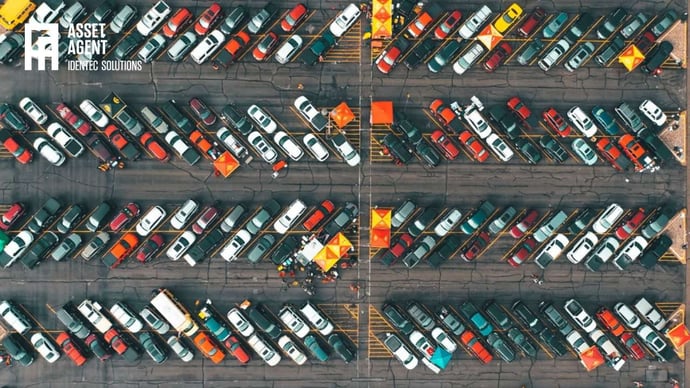Leverage RFID for Smarter Asset Tracking Operations
| Written by Mark Buzinkay
Are you looking to improve the efficiency and accuracy of your assets monitoring and tracking operations? The latest advancement in equipment management is radio-frequency identification (RFID) asset tracking. In this blog post, we'll discuss what exactly RFID asset tracking is, why it's beneficial for businesses, and how to get started with setting up an RFID asset tracking system.
Read on to learn more about the advantages of leveraging RFID technology for improved asset management solutions!
No video selected
Select a video type in the sidebar.
What Types of RFID tags Exist?
As there are two types of RFID tags, we will first briefly describe them and discuss their benefits and functionalities (read more about Asset tracking RFID software).
Active RFID Tags
Active RFID tags, like passive tags, can be used for asset tracking. But, unlike passive tags, active RFID tags contain a battery and will emit their own signal. This makes them more reliable and offers a more extended read range than their passive counterparts—up to 300 meters in some cases.
Active RFID asset tags are ideal for tracking high-value assets because of the long read range, but they're also often larger than passive tags. The increased size means that they can be difficult to conceal when attached to equipment or valuable items. They're also much more expensive than passive tag options as they contain more components and offer greater functionality. Additionally, an active tag's battery can eventually run out, so it must be regularly checked to ensure they're still functional.
Accessibility and customizability are also a concern when using active tags. The read range is much more impressive than passive tags, but the customisation options tend to be limited because of the extra components inside the tag. In addition, different active tags may have different levels of functionality, so you should research your options carefully before selecting an RFID system for asset tracking.
Overall, active RFID asset tags offer a robust solution for keeping track of valuable items with their reliable signal and long read range. Still, it's important to remember that these come at a higher cost than passive RFID tags. Additionally, there may be some limitations on customizability, and certain environmental factors can affect their performance.
Passive RFID Tags
Passive RFID tags are the most commonly used asset tracking solution due to their lower cost and wide range of accessories and customisation options. Unlike active tags, passive RFID asset tags don't contain a battery and rely instead on the energy emitted from an external reader to activate their signal. This limits the read range of passive tags, but they offer greater flexibility regarding size and form factor, making them easier to conceal on valuable items or equipment.
Passive RFID asset tags also tend to have fewer components than active tags, so there may be limitations in terms of which materials they can be attached to. Depending on your chosen RFID system, you may also have access to additional features such as temperature and humidity sensors.
Overall, passive RFID tags offer an affordable solution for asset tracking with a wide range of customisation options and accessories available. However, the read range is limited, and specific environmental considerations can affect their performance. Additionally, different materials may require specific types of tags to ensure they're tracked accurately (1).
While exact figures for the total number of passive RFID tags in circulation are not readily available, the widespread adoption of this technology suggests that billions of passive RFID tags are in use worldwide. For instance, in 2017, sales of passive RFID sensor tags were expected to reach approximately 5.2 million units, indicating substantial growth in the years since. (2)
How to include assets in an RFID Asset Tracking System?
RFID asset tracking systems use radio frequency identification (RFID) tags to identify and monitor assets, linking digital asset profiles with physical tags. These tags have unique ID codes stored in their memory chip which specialised readers can read. RFID asset tracking software allow users to quickly and accurately track the location of a wide variety of items, such as tools, equipment, and inventory.
Asset tracking RFID software offers more granular visibility into the movement of individual assets than barcode scanning or manual entry can provide. This allows companies to better manage their assets by identifying problems like idle times, expiring, theft or misuse before they become major issues. Additionally, RFID asset tracking systems are suitable for larger-scale implementation since they are easy to set up, require minimal maintenance and can scale with the size of a business.
RFID asset tracking software provides greater security than other types of asset tracking systems, as they can detect even minimal changes in each asset's status. This allows users to keep track of their assets more effectively and be alerted if any suspicious activity is detected. Additionally, RFID tags are typically smaller than barcodes or QR codes, making them difficult to tamper with.
Overall, RFID asset tracking systems are invaluable for businesses looking to streamline their asset management operations. With these systems in place, companies can increase efficiency and accuracy while at the same time ensuring that their assets remain secure and accounted for at all times.
With this data, you now have better visibility into the movement of assets and can easily monitor any suspicious activity. Furthermore, you can also use RFID asset tracking systems to plan ahead of time for the maintenance, repair or replacement of assets as needed. This way, you'll always be able to keep your operations running smoothly and cost-effectively.
RFID asset tags, overall, speed up these operations greatly and allow you to do more with asset tracking. You need to scan a QR code or barcode with your phone's camera, whereas with an RFID asset label, you will use external hardware (learn more about RTLS tracking).
Fixed RFID asset management
Fixed RFID asset management is highly beneficial for organisations that need to track their assets accurately, quickly and efficiently. With a fixed RFID asset tracking system in place, users can easily monitor which items are located where within the facility. This offers you total automation and makes it easier to keep an updated inventory of assets, as well as helps to reduce theft and loss of valuable equipment.
You'll be able to place your RFID readers in tactical locations on your premises. Then, when an RFID tag crosses the reader's RF field, your fixed reader will be able to detect the tag and which direction it's moving in. In practice, fixed RFID readers totally automate asset location tracking, contrary to handheld RFID readers.
RFID for asset tracking with Asset Agent
Asset Agent has several great features that make it the perfect asset-tracking tool. These include real-time tracking and monitoring, RFID tag integration for accuracy and accountability, insights from predictive analytics, automated alerts and notifications to ensure proper management of assets, and more.
Asset Agent also offers scalability depending on the size of the organisation or project requirements by providing a wide range of compatible hardware, such as readers, antennas, and scanners. All of this can be integrated into existing systems or ERP software, making Asset Agent a one-stop solution for all your asset tracking needs, especially for brownfield optimisation.
Furthermore, Asset Agent provides access control capabilities to allow secure entry and exit of assets. It also allows users to run reports and generate insights into asset movement that can be used for better inventory management. Asset Agent also has a mobile app component that allows users to monitor their assets' status from anywhere in real time (learn more about real time location).
These features allow Asset Agent to provide an unbeatable service when it comes to tracking and managing all types of assets, both large and small. It is ideal for businesses across various industries, including logistics and manufacturing. With its easy-to-use interface and comprehensive analytics capabilities, Asset Agent is sure to revolutionise the way you manage & track assets.
RFID for asset tracking - Takeaway
In conclusion, implementing an RFID asset tracking system can be hugely advantageous for businesses that are looking to optimise their inventory management processes. RFID technology can increase security, improve operational efficiency, reduce costs associated with asset loss or theft, and enhance customer service. Furthermore, automated alerts will ensure that any changes to an item or equipment status are addressed immediately.
If you are interested in leveraging RFID asset tracking for your operations, consider reaching out to a professional specialising in setting up these systems. They will be able to provide further guidance on how best to implement this new technology into your existing processes so that you can begin taking advantage of its benefits right away (read more about RTLS at VW Bratislava!).
Learn more about an industry 4.0 real time locating system!
Glossary
A QR code (Quick Response code) is a two-dimensional matrix barcode that stores data such as text, URLs, or other information. It can be scanned using smartphones or dedicated QR scanners to quickly access the encoded data. QR codes are widely used in marketing, inventory management, payments, and authentication due to their high data capacity, ease of use, and reliability. (3)
Sources:
(1) R. Tesoriero, J. A. Gallud, M. Lozano and V. M. R. Penichet, "Using active and passive RFID technology to support indoor location-aware systems," in IEEE Transactions on Consumer Electronics, vol. 54, no. 2, pp. 578-583, May 2008, doi: 10.1109/TCE.2008.4560133.
(2) https://www.rfidjournal.com/news/passive-sensor-tags-to-surpass-5-million-units-this-year-2/69366/
(3) Brito, J. P. (2019). QR Codes: Applications, Security, and Challenges. CRC Press.
Note: This article was updated on the 16th of January 2025

Author
Mark Buzinkay, Head of Marketing
Mark Buzinkay holds a PhD in Virtual Anthropology, a Master in Business Administration (Telecommunications Mgmt), a Master of Science in Information Management and a Master of Arts in History, Sociology and Philosophy. Mark spent most of his professional career developing and creating business ideas - from a marketing, organisational and process point of view. He is fascinated by the digital transformation of industries, especially manufacturing and logistics. Mark writes mainly about Industry 4.0, maritime logistics, process and change management, innovations onshore and offshore, and the digital transformation in general.
Related Articles
Related Product





